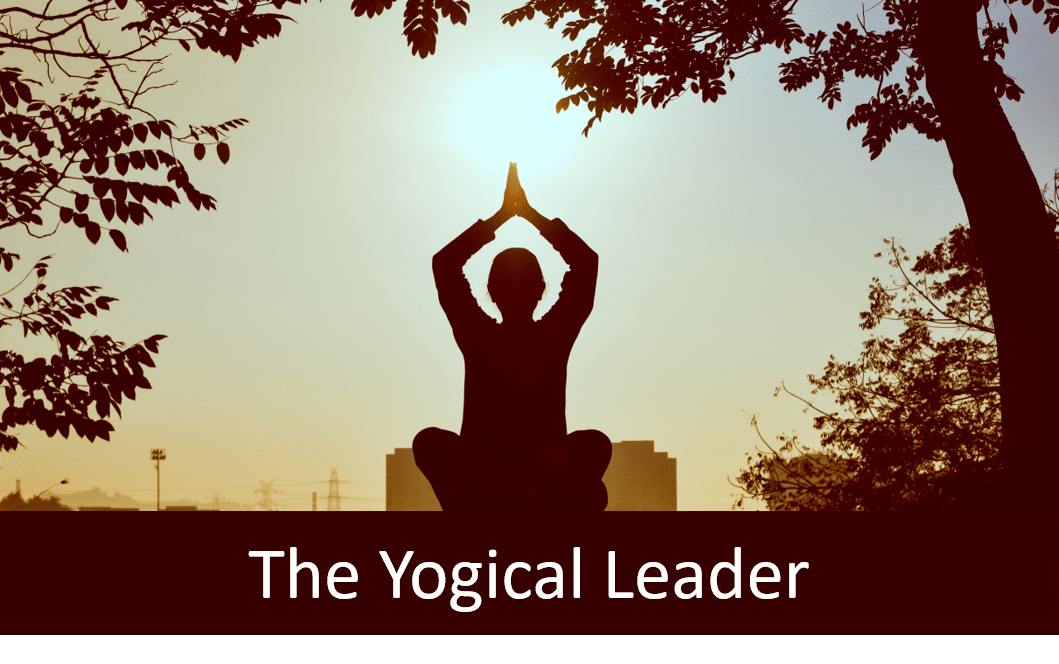Today is the 4th International Yoga day and many organizations catching up with the trend would organize seminars or workshops on Yoga. Leaders would extol the virtues of yoga, people would bend and stretch their bodies and feel rejuvenated to take on the challenges at work! And like for everything else, the momentary engagement would soon be overshadowed by the daily grind and the commitment to do something around Yoga confined to some pictures on Instagram!
Can the practice of Yoga be extended to something more than the superficial stretching of limbs? And how do we benefit from the yogic practice in our personal and professional lives? The Asthanga – The eight limbs/paths of Yoga (Asana is only one!) provide a deeper understanding to lead one’s own life and others in a productive and joyful way.
In today’s world, dominated by technology, the logical mind and the logical leader often occupy center-stage. The Yogical Leader – who blends Logic and Yoga as the way of life demonstrates the highest fruition of outer success and inner joy. The eight limbs of yoga are innately connected to the principles of leadership and my exploring these aspects, a leader would transform into a Yogical Leader. Let us explore these eight limbs and their relevance for leaders.
Asana – This is the 3rd limb/path of Yoga, but definitely the most easily understood aspect of Yoga. Various postures allow the body to become flexible and supple. The slight pain in the stretch provides the real benefit for the body. As leaders, we need to accept that pain is part of the learning and growing process. Every now and then, we need to stretch from our comfort zone and take on some pain to reach desired results. Being good to people always don’t allow for growth to happen. The absorption of this reality is something we can learn from the practice of Asanas.
Yama – The first limb deals with the ethical framework and a sense of integrity needed to lead life. Of the five Yamas – or conduct, Ahimsa and Satya are two Yamas which provide leaders to become morally powerful. The Power of Mahatma Gandhi could be attributed to these two Yama’s. For a corporate leader, the practice of Ahimsa – or non-violence is being objective in giving feedback but not aggressive. Aggression may provide short term results but erodes long term credibility. The same applies to the principle of Satya – being true to your purpose and role. Deviations from the path of Satya lead to a trust deficit eventually eroding the credibility and power of a leader
Niyama – Or path of observing disciplines is to help the individual to stay grounded and provide a strong foundation for better execution. The practice of “5-S” and Saucha – cleanliness have very similar ideology. A clean body, clean workplaces allow us to perform efficiently towards our goal. Other than the hygiene aspect, other Niyamas direct oneself towards a higher purpose. The Yogical leader focuses on having a clear vision of why we are doing what we are doing.
Pranayama – The practice of Pranayama – centered on breathing techniques is meant to harness the basic life force of Prana. The Yogical Leader realizes that it’s the presence of this life-force which brings enthusiasm and energy to life. Organizations without sufficient Prana tend to be dull, lethargic and bureaucratic. In a disruptive VUCA world, pranayama prepares leaders and organizations to be resilient, innovative and open to possibilities
Pratyahara – Withdrawal from the sensory world – might seem contradictory and abstract for a business leader. The key point for Yogical leader is to pay attention to one’s diet and also the various thought processes in the mind. Toxic diets do not allow the leader to enhance one’s ability to see things clearly. Over-indulgence in such foods like excess caffeine, alcohol or even fat heavy food is not recommended. Similarly, indulgence in gossip, backbiting or talking ill about people doesn’t do well for the leader. I have seen many successful leaders follow this path and rising out of the worldly clutter. For more reading on Pratyahara – do read the wonderful article by Dr. David Frawley – https://yogainternational.com/article/view/pratyahara-yogas-forgotten-limb
Dharana – Concentration – Focus – prepares the leader to be committed to the vision and mission they have for the organization. It brings the required resilience to counter the various distractions (money, power, fame) which will be always around. None of the benefits like money should be discarded but Dharana stops the leader from being entrapped by them.
Dhyana – Meditation or Contemplation can provide the platform for the leader to be expansive, future thinking with required clarity. The ability to deal with ambiguity and complexity is enhanced through the practice of Dayana. As the spiritual leader Sri Sri Ravishankar says, meditation brings sharpness, awareness and observation at an intellectual level.
Samadhi – The state of ecstasy, unbounded joy or self-actualization is also described as the ultimate quest of every human being. In Maslow’s hierarchy, this need is the pinnacle of human motivation. The state of Samadhi is also akin to being in the zone or flow as defined by Mihaly Csikszentmihalyi, the Hungarian psychologist. This state is the ultimate flowering in an individual’s life and a leader’s role in enabling self and others to find their flow makes them the true “Yogical Leader” and provides them the ultimate employee engagement tool.





